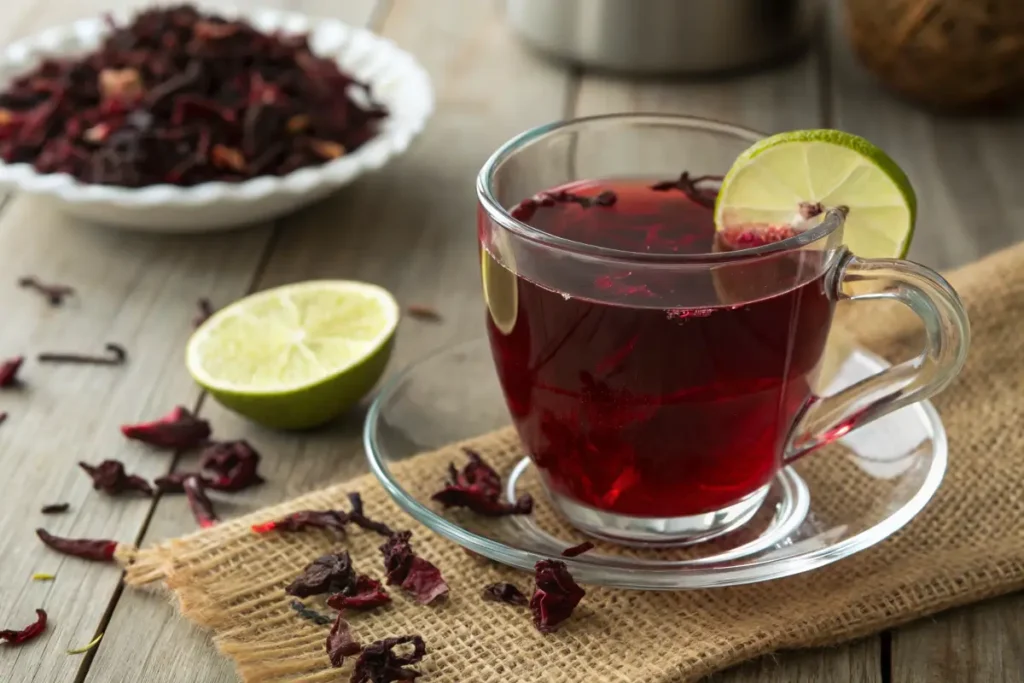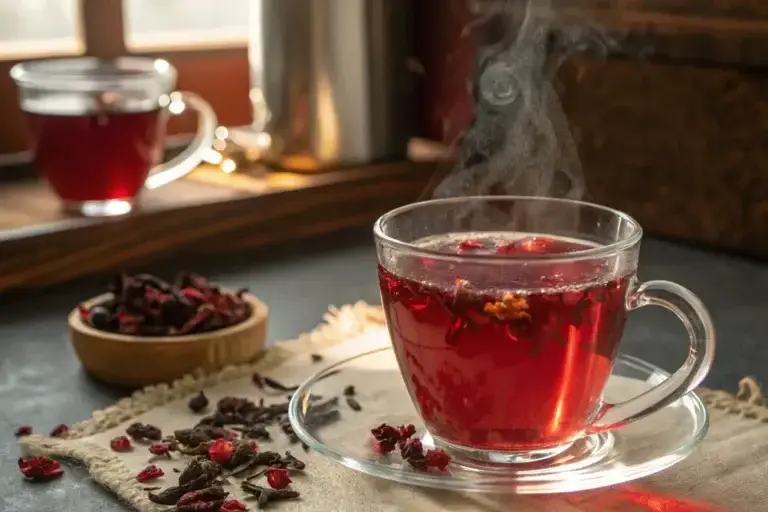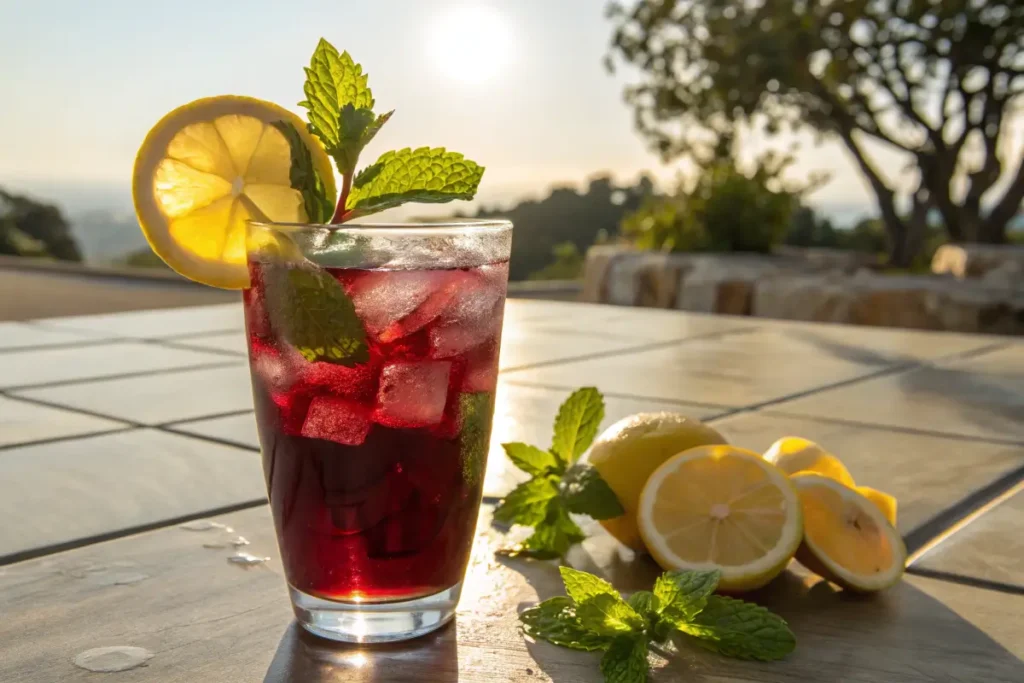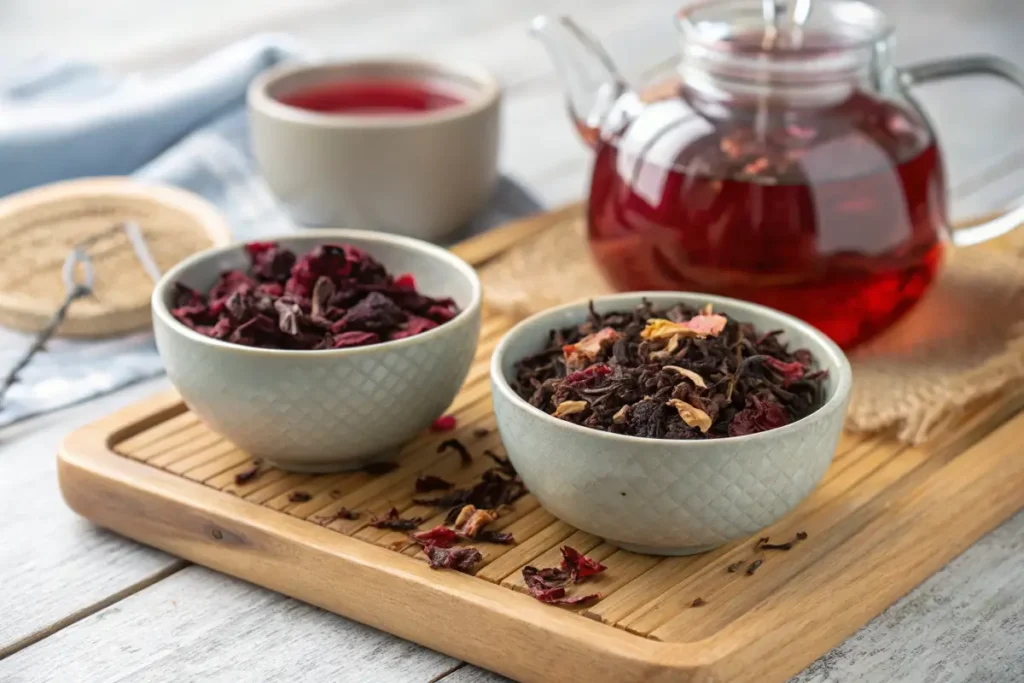
A Quick Story Before We Begin
The first time I tried hibiscus tea, I had no idea what to expect. A friend handed me a deep red, ice-cold drink on a hot summer day and said, “Trust me, you’ll love it.” One sip, and I was hooked! The tangy, slightly sweet flavor, with a hint of floral freshness, was unlike anything I’d ever tasted. Since then, I’ve been making this delicious hibiscus tea recipe at home, experimenting with different ingredients to find the perfect balance of taste and health benefits.
Want to learn how to make the best hibiscus tea recipe? Whether you love it hot or cold, I’ve got you covered!
Print
Hibiscus Tea (Hot & Iced)
This vibrant ruby-red herbal tea is naturally caffeine-free, tangy-sweet, and bursting with vitamin C and antioxidants. Brew it steaming hot for cozy nights or chill it over ice for the ultimate summer refresher—either way, the floral-fruity flavor of dried hibiscus flowers makes every sip special.
- Total Time: 15 minutes (add 60 minutes chill time for iced version if desired)
- Yield: 2 cups hot or 4 cups iced 1x
Ingredients
-
Hot Hibiscus Tea (2 servings)
-
2 cups (480 ml) water
-
2 Tbsp dried hibiscus flowers —or 4 Tbsp fresh petals
-
1–2 tsp honey, agave, or sugar (optional)
-
Slice of lime or cinnamon stick (optional garnish)
-
-
Iced Hibiscus Tea (4 servings)
-
4 cups (960 ml) water
-
½ cup (about 15 g) dried hibiscus flowers —or 1 cup fresh petals
-
2–4 Tbsp sweetener to taste
-
Ice cubes
-
Lime wedges, orange slices, or fresh mint for garnish (optional)
-
Instructions
-
Boil the water – Bring the water to a rolling boil in a saucepan or kettle.
-
Steep the hibiscus – Remove from heat, add the dried flowers, cover, and let steep: 5 min for light flavor, 10 min for balanced, 15 min for bold.
-
Strain – Pour through a fine-mesh strainer or tea infuser to remove the petals.
-
Sweeten (optional) – Stir in honey, agave, sugar, or your preferred sweetener until dissolved.
-
Serve hot – For the hot version, pour into mugs and garnish with a lime slice or cinnamon stick.
-
Chill for iced tea – Let the tea cool to room temperature, transfer to a pitcher, and refrigerate 1 hour. Serve over ice with citrus slices or mint.
Notes
-
Flavor twists: Add ginger slices for warmth or combine equal parts hibiscus tea and lemonade for a hibiscus-ade.
-
Adjust tartness: If the tea is too sharp, dilute with extra water or ice; if too mild, extend steeping time.
-
Make-ahead: Hibiscus tea keeps up to 4 days in the fridge—store without ice or citrus to preserve freshness.
-
Health reminder: Hibiscus can lower blood pressure; consult your doctor if you’re on related medication.
- Prep Time: 5 minutes
- Cook Time: 10 minutes
- Category: Beverage / Wellness Drink
- Cuisine: International / Herbal Tea
Nutrition
- Serving Size: unsweetened, per 1-cup serving
- Calories: 2 kcal
- Fat: 0 g
- Carbohydrates: 0.4 g
- Protein: 0 g
What is Hibiscus Tea?
Origins and Cultural Significance
Hibiscus tea, also known as Agua de Jamaica or Karkade, has been enjoyed for centuries across different cultures. Originating in Africa and the Caribbean, this vibrant red herbal tea has made its way into kitchens worldwide. Egyptians drank it to cool down in the desert heat, while in Mexico, it became a staple summer refreshment.
Health Benefits of Hibiscus Tea
Beyond its refreshing taste, hibiscus tea is packed with health benefits:
- Supports heart health – Studies suggest that it may help lower blood pressure.
- Aids digestion – The tea’s natural acidity supports digestion and relieves bloating.
- Rich in antioxidants – It contains vitamin C and flavonoids, which help fight free radicals.
- Promotes weight loss – Many people drink it as a metabolism booster.
Different Ways to Enjoy Hibiscus Tea
One of the best things about hibiscus tea is its versatility:
- Hot or Iced – Enjoy it steaming on a chilly day or iced for a summer treat.
- Sweet or Unsweetened – Add honey or stevia for sweetness, or enjoy its natural tartness.
- Spiced or Fruity – Try it with cinnamon, ginger, or fresh citrus slices for a twist.
Ingredients and Tools Needed
Essential Ingredients for Hibiscus Tea
Making a delicious hibiscus tea recipe starts with just a few key ingredients. Here’s what you’ll need:
- Dried hibiscus flowers – The star ingredient, also known as Jamaica flowers or Karkade.
- Water – Fresh, filtered water enhances the flavor.
- Sweetener (optional) – Honey, agave, or stevia to balance the tartness.
- Citrus (optional) – Lime or orange slices add a refreshing twist.
Optional Add-ins for Extra Flavor
Want to elevate your hibiscus tea? Try these add-ins:
- Fresh mint – Brings a cooling effect, perfect for iced tea.
- Ginger – Adds a spicy, warming kick.
- Cinnamon or cloves – Enhance the depth of flavor, great for fall and winter.
Tools and Equipment
To make this tea effortlessly, you’ll need:
- Saucepan or kettle – For boiling water.
- Mesh strainer or tea infuser – To filter out the hibiscus petals.
- Pitcher or teapot – Ideal for serving and storing.
With everything ready, let’s move on to the fun part—brewing your perfect cup of hibiscus tea!
How to Make Hot Hibiscus Tea
Step 1: Boiling the Water
Start by boiling 2 cups of water in a saucepan or kettle. If using a tea kettle, bring the water to a rolling boil. The hotter the water, the better it will extract the flavor from the hibiscus petals.
Step 2: Steeping the Hibiscus Flowers
Once the water is ready, add 2 tablespoons of dried hibiscus flowers. Cover and let it steep for 5 to 10 minutes—the longer it steeps, the stronger and more tart the flavor.
Step 3: Straining and Serving
After steeping, strain the tea using a fine mesh strainer or tea infuser. Pour into your favorite mug and enjoy!
Best Sweeteners and Flavor Enhancements
To balance the tartness, try these natural sweeteners:
- Honey – Adds a subtle floral sweetness.
- Maple syrup – A rich, earthy option.
- Stevia – A calorie-free alternative.
You can also enhance your tea with a splash of lemon juice or a cinnamon stick for extra depth.
How to Make Iced Hibiscus Tea

Step 1: Preparing the Tea Base
To make a refreshing iced hibiscus tea recipe, start by boiling 4 cups of water in a pot. Once it reaches a rolling boil, remove from heat and add ½ cup of dried hibiscus flowers. Let it steep for 10 to 15 minutes for a bold, tangy flavor.
Step 2: Cooling and Storing the Tea
Once the tea has steeped, strain the flowers using a fine mesh strainer or tea infuser. Allow it to cool to room temperature before transferring to a pitcher. For best results, refrigerate for at least an hour to chill completely.
Step 3: Adding Ice and Garnishes
Serve the tea over ice cubes for a crisp, refreshing experience. To enhance the flavor, try adding:
- Lime or lemon slices – Boosts citrus notes.
- Fresh mint leaves – Adds a cooling effect.
- Honey or agave syrup – Balances the tartness.
Refreshing Variations: Citrus, Mint, and More
Customize your hibiscus tea with these fun variations:
- Hibiscus Lemonade – Mix equal parts hibiscus tea and lemonade.
- Hibiscus Ginger Cooler – Add fresh ginger slices while steeping.
- Berry Hibiscus Iced Tea – Blend in raspberries or strawberries.
For more cooling drinks, check out this lime juice benefits and recipes guide.
Hibiscus Tea with Fresh vs. Dried Flowers
Using Fresh Hibiscus Petals

If you have access to fresh hibiscus flowers, they can be used just like dried petals. Here’s how:
- Wash thoroughly – Rinse the petals under running water.
- Boil and steep – Use double the amount compared to dried flowers.
- Strain and serve – Fresh petals give a lighter, floral taste.
Using Dried Hibiscus Flowers
Dried flowers are more concentrated and have a deeper flavor. They also last longer, making them a convenient choice. Use half the amount compared to fresh petals, and steep them for a longer time to extract their full richness.
Flavor Differences Between Fresh and Dried
- Fresh petals – Mild, delicate floral notes.
- Dried petals – Bold, tart, and slightly fruity.
Both options work beautifully in any hibiscus tea recipe, so choose based on availability and taste preference! 😊
Tips for the Best-Tasting Hibiscus Tea
Best Brewing Times for Optimal Flavor
The perfect hibiscus tea recipe depends on how long you steep the flowers.
- 5 minutes – Light and mildly tart.
- 10 minutes – Balanced with a floral and fruity taste.
- 15 minutes or more – Deep red, bold, and tangy.
Longer steeping brings out more antioxidants but also makes the tea more acidic. If it tastes too tart, try adding a natural sweetener or diluting it with extra water.
How to Adjust Acidity and Sweetness
Hibiscus tea naturally has a tangy taste, but you can tweak it to your liking.
- Too tart? Add honey, maple syrup, or agave.
- Too strong? Mix in extra water or ice cubes.
- Not enough flavor? Try fresh citrus, cinnamon, or ginger.
Pairing Hibiscus Tea with Other Ingredients
To make your hibiscus tea recipe more exciting, experiment with different flavors:
- For a cooling effect – Add fresh mint or basil.
- For a spicy twist – Try ginger or cinnamon sticks.
- For a tropical vibe – Mix in pineapple or coconut water.
By adjusting steeping time and ingredients, you can create a hibiscus tea that suits your taste perfectly!
FAQs
What Not to Mix with Hibiscus Tea?
While hibiscus tea pairs well with many ingredients, some combinations aren’t ideal. Avoid mixing it with:
- Dairy – The acidity can curdle milk.
- High-caffeine teas – Can create an overly intense flavor.
- Blood pressure medication – Hibiscus can lower blood pressure, so consult your doctor if needed.
How Many Hibiscus Flowers for One Cup of Tea?
For a standard cup (8 oz), use about:
- 1 tablespoon of dried hibiscus flowers or
- 2 tablespoons of fresh hibiscus petals
If you prefer a stronger hibiscus tea recipe, increase the amount slightly, but be mindful of the tartness.
Why Do I Feel Weird After Drinking Hibiscus Tea?
Some people may experience mild side effects like dizziness or an upset stomach. This is often due to factors such as lowered blood pressure, acidity, or allergic reactions. You can learn more about potential interactions with hibiscus tea in this study on its effects on blood pressure.
- Lowered blood pressure – Hibiscus is a natural blood pressure reducer.
- Acidity – Can cause minor stomach irritation if consumed on an empty stomach.
- Allergic reactions – Rare, but possible if sensitive to hibiscus or related plants.
If you notice discomfort, try drinking it in moderation and with food.
Is Boiled Hibiscus Good for You?
Yes! Boiling hibiscus helps extract its antioxidants and vitamins, making it even more beneficial. However, long boiling times can make it overly tart and concentrated. The best method is to steep it for 10–15 minutes rather than boiling it for extended periods.
More Resources for Hibiscus Tea Lovers
- Hibiscus Mocktail Recipe: A Refreshing Floral Non‑Alcoholic Drink – turn your brewed tea into a fizzy, party‑ready cooler
- Ginger Beer Mocktail: Refreshing Recipes & Benefits – see how a splash of hibiscus syrup brightens spicy ginger fizz
- Lemon Balm Tea Recipe: Benefits & How to Make It – unwind with another fragrant, caffeine‑free herbal brew
- Orange Peel Tea: Benefits, Recipes & How to Make It – add citrus zest to your tea repertoire for a sunny twist
- Feel Better Fast: Immunity‑Boosting Wellness Shots and Teas – discover more ways to sip your way to wellness
With these tips and FAQs, you’re now ready to make and enjoy the perfect cup of hibiscus tea! 🍵😊
